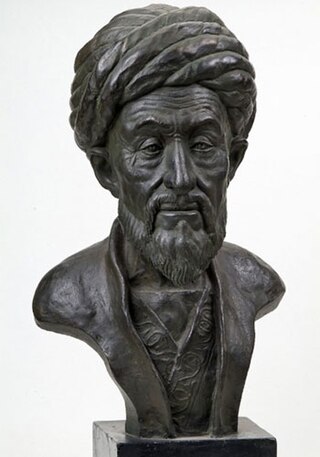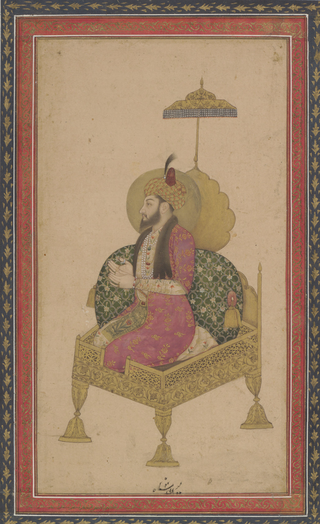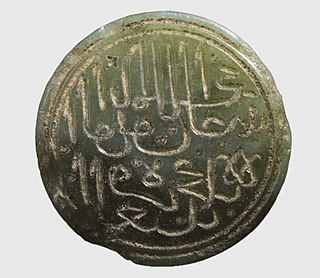
The Qara Qoyunlu or Kara Koyunlu, also known as the Black Sheep Turkomans, were a culturally Persianate, Muslim Turkoman monarchy that ruled over the territory comprising present-day Azerbaijan, Armenia, northwestern Iran, eastern Turkey, and northeastern Iraq from about 1374 to 1468.
This is a timeline of major events in the Muslim world from 1400 AD to 1499 AD.

Shah Rukh or Shahrukh Mirza was the ruler of the Timurid Empire between 1405 and 1447.

Muzaffar al-Din Jahan Shah ibn Yusuf or Abu al-Muzaffar Jahan Shah was the leader of the Qara Qoyunlu Oghuz Turkic tribal confederacy in Azerbaijan and Arran who reigned c. 1438 – 1467. During his reign he managed to expand the Qara Qoyunlu's territory to its largest extent, including Eastern Anatolia, most of present-day Iraq, central Iran, and even eventually Kerman. He also conquered neighbouring states. He was one of the greatest rulers of the Qara Qoyunlu. He was also allegedly fond of drinking and entertainment. During his reign Jahan Shah had the Gökmedrese and Muzafferiye theological schools constructed in his capital city Tabriz.

The Muzaffarid dynasty was a Muslim dynasty which came to power in Iran following the breakup of the Ilkhanate in the 14th century. At their zenith, they ruled a kingdom comprising Iranian Azerbaijan, Central Persia, and Persian Iraq. The Muzaffarids were known for their support of Arabic literature. Shah Shoja was a poet and wrote in both Arabic and Persian and was said to be capable of memorizing eight verses of Arabic poetry after hearing them read once. While the Muzaffarid ruler of Kirman, Shah Yahya, commissioned the scholar Junyad bin Mahmud Al-Umari to compile an anthology of Arabic poetry and prose for him

Mirza Jalal-ud-din Miran Shah Beg, commonly known as Miran Shah, was a son of the Central Asian conqueror Timur, founder of the Timurid Empire.
Uthman Beg or Osman Beg was a late 14th and early 15th-century leader of the Turkoman tribal federation of Aq Qoyunlu in what is now eastern Turkey, Iran, Azerbaijan and Iraq.
Shaikh Hasan, also known as "Hasan Buzurg", Hassan the Jalair or Hassan-e Uljatâï was the first of several de facto independent Jalayirid rulers of Iraq and central Iran.

Shaykh Uways Jalayir was the Jalayirid ruler of Iraq (1356–1374) and Azerbaijan (1360–1374). He was the son of Hasan Buzurg and the Chobanid princess Dilshad Khatun.

The Jalayirid Sultanate was a dynasty of Jalayir origin, which ruled over modern-day Iraq and western Iran after the breakup of the Ilkhanate in the 1330s. It lasted about fifty years, until disrupted by Timur's conquests and the revolts of the Qara Qoyunlu Turkoman. After Timur's death in 1405, there was a brief attempt to re-establish the sultanate in southern Iraq and Khuzistan. The Jalayirids were finally eliminated by the Qara Qoyunlu in 1432.
Sultan Ahmad was the ruler of the Jalayirid Sultanate, he was son to the most accomplished ruler of the sultanate, Shaykh Uways Jalayir. Early in his reign, he was involved in conflicts with his brothers. He would later suffer from several defeats with Timur and eventually imprisoned by the Mamluks. After being set free, he attacked his old enemy, the Qara Qoyunlu but was later captured and executed 1410.

The Aq Qoyunlu or the White Sheep Turkomans was a culturally Persianate, Sunni Turkoman tribal confederation. Founded in the Diyarbakir region by Qara Yuluk Uthman Beg, they ruled parts of present-day eastern Turkey from 1378 to 1503, and in their last decades also ruled Armenia, Azerbaijan, much of Iran, Iraq, and Oman where the ruler of Hormuz recognised Aq Qoyunlu suzerainty. The Aq Qoyunlu empire reached its zenith under Uzun Hasan.

Abu NasrQara Yusuf ibn MohammadBarani was the ruler of the Qara Qoyunlu dynasty from c.1388 to 1420, although his reign was interrupted by Tamerlane's invasion (1400–1405). He was the son of Qara Mahammad Töremish, a brother-in-law to Ahmad Jalayir.

The Battle of Chapakchur was a decisive battle fought between Qara Qoyunlu under the leadership of Jahan Shah and Aq Qoyunlu under the leadership of Uzun Hasan. Jahan Shah was defeated by Uzun Hasan in a battle near the sanjak of Çapakçur in present-day eastern Turkey on October 30, 1467.

The Battle of Nakhchivan was fought between Kara Koyunlu under their Bey, Qara Yusuf and the Timurid Empire under the leadership of Timur's grandson Abu Bakr ibn Miran Shah, for control of Azerbaijan on October 14, 1406. Qara Yusuf decisively defeated the Timurids in this battle and took over Tabriz, the capital of the region.
Tandu Khatun or Tindu Khatun was a Jalayirid princess and sovereign of the Jalairid Sultanate in Iraq in 1411–1419.

Ahmed Lur was a primary Luri follower of the Hurufism school of Sufi Islam in 15th century in Iran. He was one of the disciples of Fazlallah Na'imi, the founder of the Hurufism sect.

Qara Mahammad Barani Yiwa was a bey of the Qara Qoyunlu and father of Qara Yusuf.
The High Middle Ages, or Classic Feudalism Period in what constitutes the present-day Republic of Azerbaijan, lasted from around the 11th century to the 15th century AD. The High Middle Ages were preceded by the Early Middle Ages and were followed by the Late Middle Ages, which ended around the 15thcentury AD. Key historical trends of the High Middle Ages include the incorporation of the territories that constitute present-day Azerbaijan into the Seljuk Empire, the establishment of the Eldiguzids, the Mongol invasions and the rule of the Ilkhanate, the invasions of Timur and the establishment of the Turkoman Kara Koyunlu and Aq Qoyunlu tribal confederations.

The siege of Alinja occurred between the armies of the Jalayirid Sultanate and Timurid Empire starting in 1388. Two offensives by the Qara Qoyunlu would interrupt the sieges, but by 1396 Miran Shah had resumed besieging the fortress. In 1399, George VII of Georgia attacked the Timurids and released some of those who had been imprisoned. In retaliation, Timur ravaged southern Georgia and northern Armenia, killing, destroying, and enslaving people. The fortress managed to withstand the intermittent siege, but faced with starvation, surrendered in 1401.













